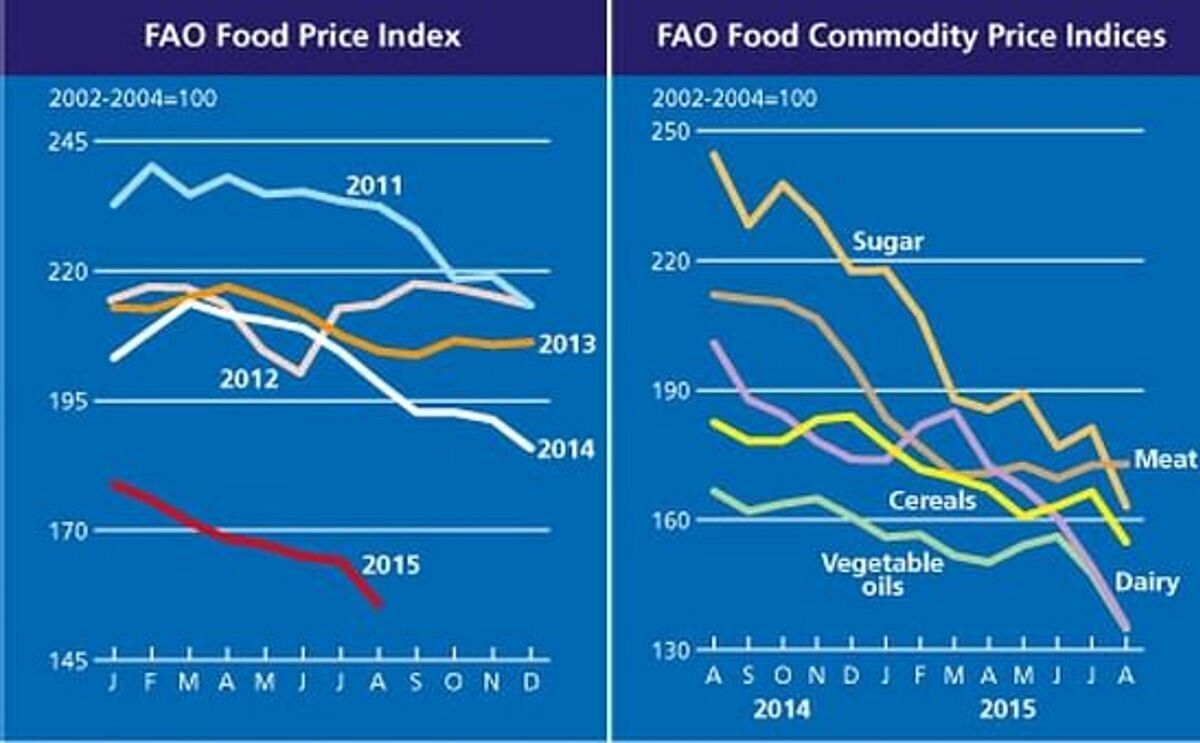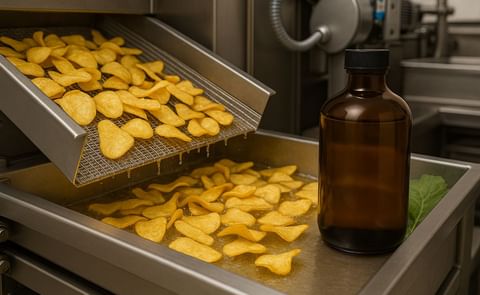In August 2015, the FAO Food Price Index saw its biggest decline since 2008
FAO Food Price Index for August saw sharpest drop since 2008

The FAO Food Price Index averaged 155.7 points in August 2015, down 8.5 points (5.2 percent) from July, the sharpest monthly drop since December 2008.
In addition to ample supplies, a number of other factors contributed to the decrease, including the slump in energy prices and concerns about China’s economic slowdown and its negative consequences on the global economy and financial markets.
The decline affected all the commodities tracked by the index, except for meat, the prices of which remained generally steady.
The FAO Cereal Price Index averaged 154.9 points in August, down 11.6 points (7.0 percent) from July and 27.6 points (15.1 percent) from last year. The decline in August, which reversed two consecutive months of modest increases, brought the index down to its lowest level since June 2010. Falling wheat and maize prices were the main factors for the downturn although rice prices also weakened in August. Abundant wheat supplies, supported by larger than anticipated harvests in the northern hemisphere, where the season is coming to a close, pushed down wheat values. Maize prices dropped too, mainly on improved production prospects in the United States and expected larger sales from Brazil this season. Rice quotations also subsided over the month, albeit marginally, reflecting strong competition among exporters.
The FAO Vegetable Oil Price Index averaged 134.9 points in August, down 12.7 points (8.6 percent) from July and the lowest level since March 2009. The protracted slide in the index primarily reflects developments in palm oil markets. International palm oil prices have hit a six-and-a-half year low, as a result of slowing import demand, notably by India and China amid expectations of rising production. The prospect for ample global soybean supplies in 2015/16, sliding mineral oil prices and concerns about the economic slowdown in China also put palm and other edible oil prices under downward pressure.
The FAO Dairy Price Index averaged 135.5 points in August, down 13.6 points (9.1 percent) from July. As in the previous three months, milk powders were most affected, although cheese and butter prices also dropped substantially. Limited import demand from China, the Near East and North Africa continued to weigh on international dairy markets, especially as export availabilities remained generally ample. As seasonal milk production shifts from the northern to the southern hemisphere, attention is turning to developments in the newly-commenced dairy year in Oceania.
The FAO Meat Price Index averaged 172.9 points in August, virtually unchanged from the previous month. International prices of ovine meat moved up somewhat, while those for other types of meat were stable. Nevertheless, compared to the index’s historic peak in August 2014, overall prices were down by 18 percent, with pig and ovine meat the most affected, although poultry and bovine meat quotations also slid markedly over the period.
The FAO Sugar Price Index averaged 163.2 points in August, down 18.1 points (10.0 percent) from July 2015. The sharp fall in the sugar index was largely the result of the continued depreciation of the Brazilian Real against the US Dollar and firmer expectations that India, the world’s second largest sugar producer, will become a net exporter in the current 2015/16 season. Official reports that Thailand, the world’s second largest sugar exporter, would harvest a smaller sugarcane crop in 2015/16 were not sufficient to contain the slide in sugar quotations.
In addition to ample supplies, a number of other factors contributed to the decrease, including the slump in energy prices and concerns about China’s economic slowdown and its negative consequences on the global economy and financial markets.
The decline affected all the commodities tracked by the index, except for meat, the prices of which remained generally steady.
The FAO Cereal Price Index averaged 154.9 points in August, down 11.6 points (7.0 percent) from July and 27.6 points (15.1 percent) from last year. The decline in August, which reversed two consecutive months of modest increases, brought the index down to its lowest level since June 2010. Falling wheat and maize prices were the main factors for the downturn although rice prices also weakened in August. Abundant wheat supplies, supported by larger than anticipated harvests in the northern hemisphere, where the season is coming to a close, pushed down wheat values. Maize prices dropped too, mainly on improved production prospects in the United States and expected larger sales from Brazil this season. Rice quotations also subsided over the month, albeit marginally, reflecting strong competition among exporters.
The FAO Vegetable Oil Price Index averaged 134.9 points in August, down 12.7 points (8.6 percent) from July and the lowest level since March 2009. The protracted slide in the index primarily reflects developments in palm oil markets. International palm oil prices have hit a six-and-a-half year low, as a result of slowing import demand, notably by India and China amid expectations of rising production. The prospect for ample global soybean supplies in 2015/16, sliding mineral oil prices and concerns about the economic slowdown in China also put palm and other edible oil prices under downward pressure.
The FAO Dairy Price Index averaged 135.5 points in August, down 13.6 points (9.1 percent) from July. As in the previous three months, milk powders were most affected, although cheese and butter prices also dropped substantially. Limited import demand from China, the Near East and North Africa continued to weigh on international dairy markets, especially as export availabilities remained generally ample. As seasonal milk production shifts from the northern to the southern hemisphere, attention is turning to developments in the newly-commenced dairy year in Oceania.
The FAO Meat Price Index averaged 172.9 points in August, virtually unchanged from the previous month. International prices of ovine meat moved up somewhat, while those for other types of meat were stable. Nevertheless, compared to the index’s historic peak in August 2014, overall prices were down by 18 percent, with pig and ovine meat the most affected, although poultry and bovine meat quotations also slid markedly over the period.
The FAO Sugar Price Index averaged 163.2 points in August, down 18.1 points (10.0 percent) from July 2015. The sharp fall in the sugar index was largely the result of the continued depreciation of the Brazilian Real against the US Dollar and firmer expectations that India, the world’s second largest sugar producer, will become a net exporter in the current 2015/16 season. Official reports that Thailand, the world’s second largest sugar exporter, would harvest a smaller sugarcane crop in 2015/16 were not sufficient to contain the slide in sugar quotations.
Like to receive news like this by email? Join and Subscribe!
Get the latest potato industry news straight to your WhatsApp. Join the PotatoPro WhatsApp Community!
精选企业
Sponsored Content
Sponsored Content
Sponsored Content
Sponsored Content









